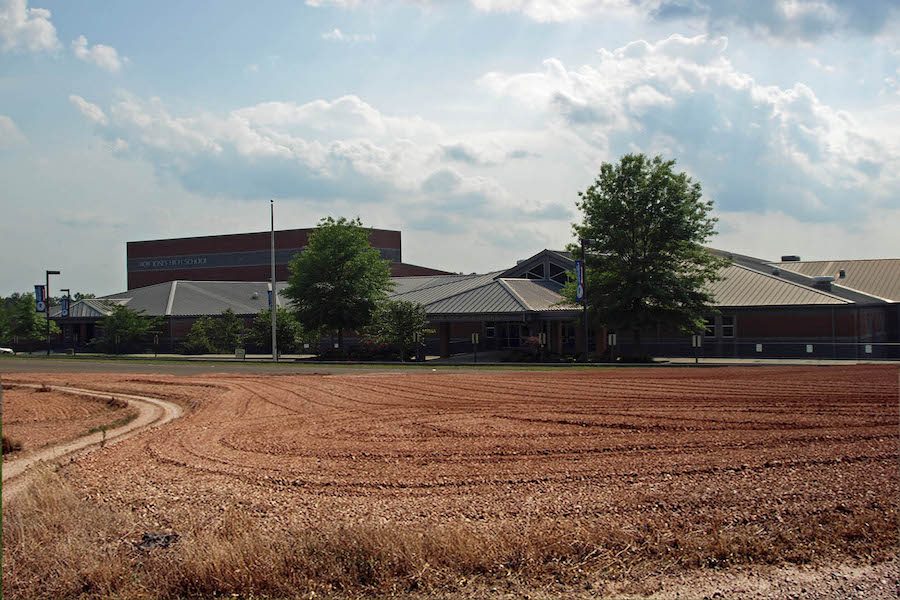Agriculture and Forestry at Bob Jones: Overlooked and Underappreciated
Bob Jones is void of Agricultural and Forestry classes. Credit: By Pexels.com https://www.pexels.com/photo/sky-clouds-cloudy-earth-46160/; By Spyder_Monkey (Own work) [CC BY-SA 3.0 (http://creativecommons.org/licenses/by-sa/3.0)], via Wikimedia Commons
December 6, 2016
When I look at Bob Jones High school, I see a school that is blessed with classes that cater to the many career fields in this world, but as a rising sophomore, I’ve noticed that the school seems to fall short in the areas of study pertaining to agriculture, forestry, and their related fields. When I consider how agriculturally dependent the state of Alabama is, along with the growing importance of agriculture in the nation–not to mention in the world–I can’t help but ask, why is this so?
Alabama’s economy, even today, is deeply rooted in agriculture. In centuries past, Alabama was once a dominating economic force in the United States. The state, according to the Encyclopedia of Alabama, made up 22.9 percent of the nation’s cotton production in 1859 and dominated the cotton industry. Alabama was once one of the agricultural powerhouses of the United States; it served as a major economic foundation for the nation.
Forestry in Alabama has played a huge role in its economy as well; the Encyclopedia of Alabama states, “From the late nineteenth century through World War I, the South was the nation’s leading lumber producer… producers supplied more than one-third the nation’s lumber.”
The true beauty of Alabama is not found in technology and vast industrialization but in its abundance of natural resources. Alabama once served as one of the main producers of natural resources in the United States, and even today, Alabama’s biological legacy remains within its economy. The Alabama Cooperative Extension Service said that Alabama had generated $70.4 billion from agriculture, forestry, and their related industries (horticulture, floriculture, agroforestry, etc) in 2010. These same industries, as of 2010, contributed to 40 percent of Alabama’s gross domestic product, or according to Oxford Dictionaries, “The total value of goods produced and services provided in a country [or state] during one year.”
Considering how rich Alabama’s history is in agriculture and forestry, it can be assumed that Agricultural and Forestry classes are available at one of the top schools in Alabama, but unfortunately, Bob Jones lacks classes in both of these career fields. On Bob Jones’s website, there is nothing to be found pertaining to either of these fields, unless you include the Greenhouse activity during Patriot Path or Mr. Lanford’s Agriscience Class. There are no classes for Agriculture, no classes for Forestry, and no classes for any of their related fields (with the exception of environmental science). To me, it makes no sense as to why there are virtually no classes that cater to these areas of study. We are, according to Usnews.com, ranked sixth in our state, a state functioning primarily on agriculture and forestry. And we, unfortunately, have few classes that even give us a glimpse as to what we can expect in these career fields. Even James Clemens, ranked seventeenth in Alabama, has Future Farmers of America, a national organization endorsing agriculture and leadership, and although James Clemens provides no means of contact for their program, we, Bob Jones, still provide a minute amount of classes in these fields. If we are a state that’s as reliant on these areas of study as our economy shows us, then why don’t we, a leading school in Alabama, have classes that cover these fields? I think that more needs to be implemented within our school for these important areas of study.
Students at Bob Jones are also aware of the scarcity of agricultural and forestry classes at the school. In a poll of 115 students, sixty-three agreed that the school lacked courses pertaining to agriculture and forestry (in addition to their related fields). Senior Chris Zuckerman said, “It’s kind of sad because, I mean, there’s a lot of classes here, but it doesn’t seem like there’s really anything here [at Bob Jones that covers these areas of study] besides the Greenhouse, and Mr. Lanford’s Agriscience class].
Despite the lack of exposure, there is some student interest in these fields. In the same survey of 115 students, only forty-two answered that they wouldn’t be interested in taking agricultural and forestry classes.The remaining sixty-nine answered favorably, with thirty-two saying they would be interested and thirty-seven saying that they may be interested. However, exposure to classes directly affects student interest, for how does a student know whether he or she is interested in a particular field if a school hasn’t provided opportunities for them to take? This result is a reflection of the lack of exposure within our school. We won’t know for sure how many students are interested until classes catering to these fields are provided here at Bob Jones.
Agriculture and Forestry are career fields that just can’t be overlooked. World population is increasing, and as the world continues to grow, the demand for Agriculturalists and Foresters will grow, too. The United Nations reported that the world’s population, as of mid-2015, sat at a huge 7.3 billion people, but this number shrinks in comparison to the colossal 9.3 billion people predicted to inhabit the earth by 2050.
With an increasing population comes an increasing demand for resources–one of them being food. According to usaid.gov, food demand, as of 2016, is expected to experience at least a sixty percent increase by 2050.
Because of these conditions, the economic climate is perfect for those going into agriculture and or forestry. Innovations in agriculture, along with advances in agroforestry, are already being made within our nation, and with these changes will come benefits to people around the globe.
We are living in an age of opportunity–now is the time for aspiring students to get informed and involved, but in order for this to be, schools have to provide the means of exposure for students interested in these fields… something that Bob Jones just isn’t doing right now.
Some may argue that Huntsville’s industries take priority over agriculture, but what would be of Huntsville, if those industries were taken away? According to the Encyclopedia of Alabama, Huntsville once played an important part in the cotton economy of the state and quickly gained wealth through its thriving agricultural industry.
This changed, however, when the U.S. Army established what is now Redstone Arsenal in 1941 as a result of World War II. Because of this, Huntsville’s economic structure transformed from agriculture to that of aerospace and defense, information and technology, and other industries. Cotton mills, like the refurbished Lowe Mill, now stand as reminders of Huntsville’s distant agricultural past. But what if the past isn’t as far as we think it is? Huntsville became what it is today only because of the military presence within the city. What if that presence were to disappear–what if Redstone Arsenal closed? It’s possible that it could; plenty of military installations have either closed or moved in the U.S. before. What would become of Huntsville and its industries if it did? Without the presence of Redstone Arsenal, Huntsville could become again, a town built on agriculture.
With this in mind, agriculture is still a very important field in today’s world, and it should share a part alongside Huntsville’s other industries. It should be represented at Bob Jones and other schools within the community, and more academic opportunities should be given to the students of Madison.
It’s a shame that there’s very little representation of agriculture and forestry at Bob Jones. These fields are the backbone of our city, of our state, and are the future of this world. The growing demand for workers in these fields opens many opportunities for students, but the lack of exposure is what hurts many who want to learn more. People who have careers in these fields provide us food and materials that allow us to construct our communities, yet we can’t even provide for them a future generation of agriculturalists and foresters to help keep these industries alive… Something has got to change, Bob Jones,..something has got to change.












